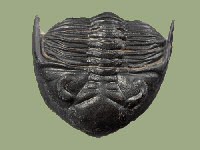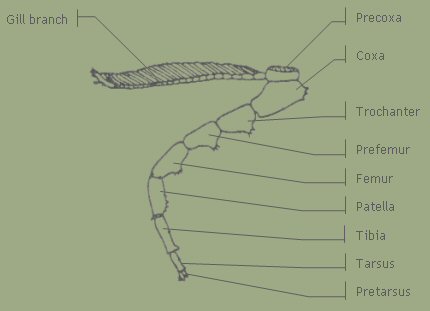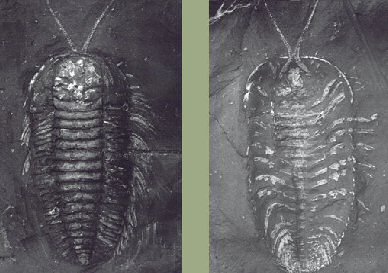|
|
|
TRILOBITA::
Homepage:: Trace fossils:: Preparation:: Cabinet:: Literature:: Links:: Geological Time:: Special:: Explanations::
The Team :-)
Comments:: The Arthropoda:: Exoskeleton:: The Cephalon:: Trilobites eyes:: Limbs:: Enrollment:: Habitats::
Trilobite Orders::
|
The Secret of Trilobites Limbs |
|
|
The riddle of trilobites limbs was finally solved just in second half of the 19th century (Walcott, Beecher).
The limbs of the arthropods have different functions like movement, sensory perception or feeding. Regarding to this the trilobites are comparable with their recent relations of tribe, the Crustacea. The strongly segmented (movability) antennas projecting from the hypostomes lateral notches beyond the doublure.
The limbs (ventral appendage) are paired. The anterior limbs being of use of perception of food and feeding, care of brood asm.. On the other hand the primary use of the thoracic limbs is locomotion, however sometimes at predaceous representatives of trilobites the use of this limbs was the fixing of prey. In opposite to their recent representatives all ventral appendages are developed nearly isogenous. That is there's no functionally significant scructure or in other words, there's no variation of cleft feet to specialized structures (e.g. mouthparts for use of dissection of food, or only specialized for locomotion).
|
|
|
Basically trilobites cleft feet consisting of hip (coxa), thigh (femur), lower leg (tibia) and foot (tarsus). The base limb (sympodia) is designed by precoxa and coxa. Afterwards trochanter are following, which the 2. trochanter is called prefemur. The junction to tibia is done by patella. Furthermore a trilobites cleft feet is divided into an external branch (exopodite) and an inner branch (endopodite), comparable to the recent representatives of Crustacea. Exopodite consits of lateral gill branch. The inner branch of cursorial leg is called telepode and consits of the segments trochanter to pretarsus included.
|
Cleft feet |
|
This theory shall be clarified with the following graphics, showing a representative of the Order Ptychopariida (Suborder Olenina). At dorsal view the gill plumes are to be noticed immediately at ventral appendages.
|
Triarthrus eatoni (dorsal, ventral) (Souce: Trilobites, Levi-Setti, 1993)
|
|
|
|
|
|
|
|
|
|
|
|
|
|
|
|




